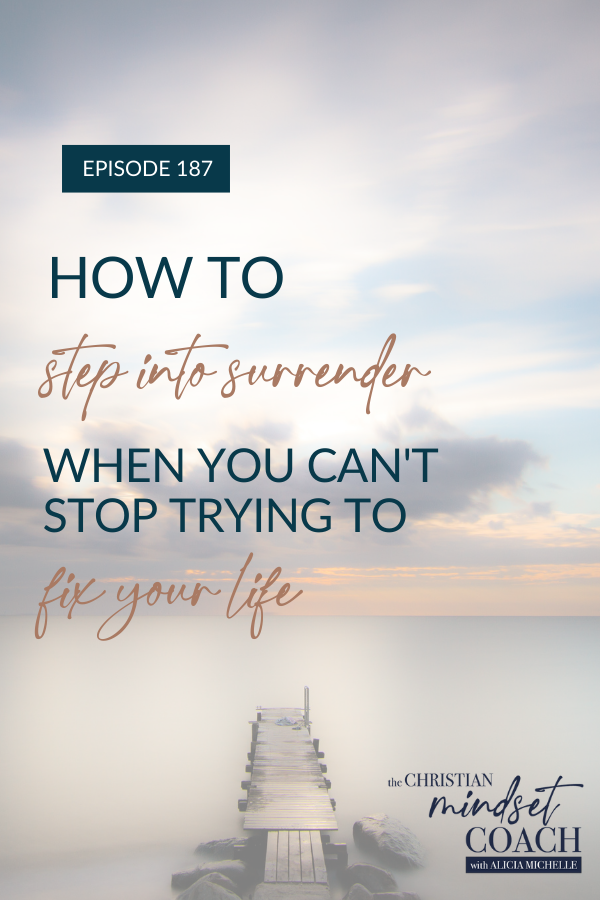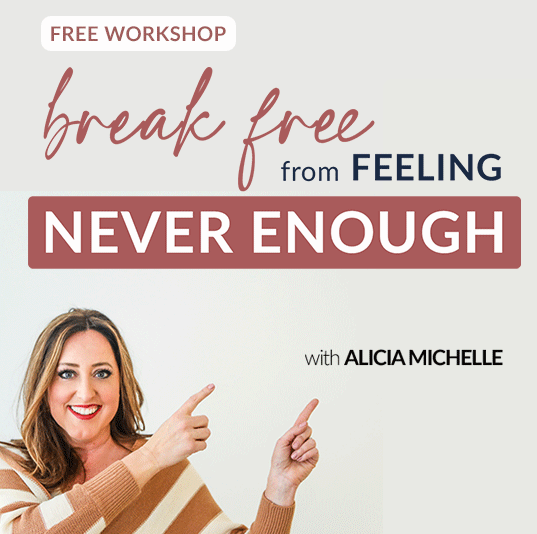Welcome to the second half of this two-part conversation about active surrender. In Part 1 of our conversation, we discussed what having a posture of active surrender really means, and what keeps us from fully surrendering to God.
Today we’re talking about how to step into active surrender, specifically 8 ways we can release our tendencies to control our lives and trust God as we choose the posture of surrender.
If you’re a self-described “control freak”, then be sure to check out both Part 1 and Part 2 of these episodes on surrender!

WHAT YOU'LL LEARN:
- [02:18] What Is Active Surrender?
- [02:47] Active Surrender Step #1: Keep Pursuing In Prayer
- [03:27] Active Surrender Step #2: Consider Your Attitude in Prayer
- [07:54] Active Surrender Step #3: Stay Connected to God’s Word
- [09:02] Try This Powerful Tool for Managing Emotions When Practicing Active Surrender
- [09:46] Active Surrender Step #4: Surround Yourself with Mature Believers Who Will Speak Truth
- [10:29] Active Surrender Step #5: Expect God to Show Up
- [11:28] Try This Tool to Recognize God at Work in Your Life
- [13:13] Active Surrender Step #6: Reflect On How God Showed Up In the Past
- [15:35] Active Surrender Step #7: Watch Out for the Enemy’s Lies
- [17:27] Active Surrender Step #8: Stop Trying to Predict the Verdict
- [18:42] Try This Tool to Manage In the Moment Emotions
[02:18] What Is Active Surrender?
We went into more detail about the posture of active surrender in part one of this two part series, but the posture of active surrender is a reminder that we can't control the situation and that God may be telling us to stop trying to take control. Instead we are called to control our posture, which is how we position ourselves throughout the situation.
Here’s 8 ways we can put ourselves in the posture of active, godly surrender.
[02:47] Active Surrender Step #1: Keep Pursuing In Prayer
Luke 18:1-8 shares a beautiful story of a persistent widow who keeps coming to a judge to ask for help in her situation. Just as the widow continued to pursue the help of the judge, we should always be pursuing and be in prayer with God.
We are called to continue to keep knocking, keep asking, keep seeking God. We are meant to be in constant pursuit of His word, connecting with God on a deeper level, trusting Him and depending on Him for guidance. This practice of constant pursuit will open up a new level of intimacy with the Lord.
[03:27] Active Surrender Step #2: Consider Your Attitude in Prayer
When it comes to your prayer life, are you praying with a desire for God to hear you and carry out His will, or are your prayers almost commanding God to do something? I have been guilty of this numerous times.
When I get into that kind of prayer mindset, my prayers become demanding. They sound like I’m asking God to perform something for my benefit instead of a hands off prayer like Jesus prayed, “Not my will, but Yours be done.”
When we pray with these repetitive, demanding prayers, asking why God isn’t immediately solving the situation in the way and in the time frame that we’d prefer, we’re increasing our anxiety, and that’s not helping anyone.
However, when we come to prayer with a mindset of release, of surrendering our needs to God, we can pray and present our situation, and then release it to Him. Then our prayers can be focused on praying for guidance to keep our hearts in the right place. It’s a continual watching of mindset.
Question to consider:
- Are you praying with a desire for God to hear you, or commanding God to do something?
[07:54] Active Surrender Step #3: Stay Connected to God’s Word
Psalm 1 describes the believer who meditates on God’s word and is planted like a tree by streams of water, which also paints a wonderful example of someone in a posture of receiving.
When we stay in a posture of receiving, we continue to stay connected to God and receive His encouragement and direction in every area of our lives. When we trust that we don’t have to have it all figured out, and know that God will provide everything we need, that is when we prosper.
We can practice entering a position of receiving through connection with Him, by being in His word everyday and being reminded of His promises.
Question to consider:
- How can I seek God and practice being in the posture of receiving today?
[09:02] Try This Powerful Tool for Managing Emotions When Practicing Active Surrender
Life is full of moments that can stir up every emotion from happiness to despair. There's a practice that I encourage women to do called Morning Pages, where you sit down with a journal in these moments and you write three pages. The writing doesn’t have to come to any sort of conclusion, and is typically what I refer to as a “brain dump” of everything you're feeling. Even if you don’t know what you’re feeling, I encourage you to simply start writing.
When we start putting down our emotions on paper, it makes it a little easier to reflect on and then eventually let it go and give it to God. Part of the posture of receiving is also being able to release things that are getting in the way of our relationship or trust with Him, and this is a practice that I have found very helpful for myself and for the women that I work with.
[09:46] Active Surrender Step #4: Surround Yourself with Mature Believers Who Will Speak Truth
It can feel good to be surrounded with people who are going to agree with us, pat us on the back, and console us when needed, but what we really need is to surround ourselves with godly people who will do all of that while also being willing to call us out when we need it.
I will never forget the moment a close friend of mine told me that I needed to stop striving. She was completely right in that moment and it was something that I needed to hear, and I was so thankful to have someone who knew me well enough to tell me what I needed to hear as a mature believer and not just what I wanted to hear. It gave me that nudge I needed to listen to the Holy Spirit’s call to active surrender.
A question to reflect on:
- How can you surround yourself with wise, mature believers?
[10:29] Active Surrender Step #5: Expect God to Show Up
There is a power in the awareness of God, which is why it’s important to look for God and His work all around you. When you practice this posture of recognizing, you give yourself the mindset of being open and expectant of God. You trust that He is in your life, working and active, which gives us the ability to persevere.
God loves us, and wants to encourage us, so slow down enough to notice His work in your life. Be in the practice of thanking God for every little thing.
[11:28] Try This Tool to Recognize God at Work in Your Life
As we connect with God each day it’s important to receive His wisdom from time in the Bible itself, However, we can also practice recognizing Him at work. I’ve found this blend of gratitude, spirituality and awareness to be an essential spiritual tool overall but exceptionally helpful for maintaining a posture of active surrender.
One of the ways I practice this, and encourage others to do the same, is to write down three specific things that have happened in the last 24 to 48 hours that are a reflection of how we have seen God truly at work in our life. What have we seen Him doing?
Now, we're not usually talking about things like parting the Red Sea, or other very obvious miracles, but we're talking about something that happened that was a teaching moment for you. It could be a moment of encouragement where someone said something to you that you really needed to hear, an unexpected blessing like someone buying a coffee for you, or simply just witnessing a beautiful sunset.
In this practice of recognizing God at work in the everyday, we realize even more that God is the one who controls all of the comings and goings of our lives. What a gift to be able to see Him actively at work. This kind of daily awareness is similar to a gratitude practice, but it’s much more specific because it allows us to see them as God sightings, and when we see God sightings that encourages us to keep going, to keep trusting, and to keep knowing that He is here with us.
Tips for putting this into practice:
- Write down what you see God doing throughout your day (Big or little things, it doesn't even have to relate to the situation you're going through.)
- Ponder it. Think about the significance of the God of the universe, showing himself real to you in these little ways.
- Tell others about it. This may be an opportunity of witnessing that he's put in your life.
- Thank God for it and celebrate every little thing.
[13:13] Active Surrender Step #6: Reflect On How God Showed Up In the Past
When it comes to the mental training of our faith, there are a lot of things we can practice, but there is one simple habit that can begin acting out now to keep ourselves focused on who God is, versus the pain of any situation we may find ourselves in: Remembering and thanking God for the times we saw Him show up in the past. This practice is a way to encourage us to stay in the posture of active godly surrender.
When tough situations arise in life, it’s human nature to enter fight or flight syndrome, and to try to rush ahead and fix things in order to avoid getting hurt. It’s important in these moments to have the ability to calm our minds, leaning on the trust that we have with God, knowing that He is faithful.
David does this in the Psalms as a way to help him release the situation, often entering a Psalm with an expression of his emotions and then he recalls the goodness of God and it calms his heart.
[15:35] Active Surrender Step #7: Watch Out for the Enemy’s Lies
Even when we are in a steady practice of being in a posture of active surrender, it’s important to watch the little lies of discouragement that the enemy will try to slip in. He knows how to wound us, targeting our weakest areas in moments when we are especially vulnerable.
Be on guard, expect it to happen, and watch for it so that when those lies from the enemy do arise, you can be quick to work through them.
You may hear lies such as “You’re not good enough,” or “God doesn’t care about you.” It’s in these times especially we need to believe these promises that God is at work, that our prayers are being heard, and that our issue is important to God, because that's all biblical truth.
[17:27] Active Surrender Step #8: Stop Trying to Predict the Verdict
This one is really hard for me, and it’s a posture that I’ve had to learn over and over: We need to stop trying to predict the verdict. When I try to predict the verdict of what I’m praying for, I don’t realize that I’m very quickly stepping out of active godly surrender. I’d start to have conversations with God that sounded like, “Oh God, maybe you should do this and tell this person this and then they’ll be able to see the truth.” It’s another way we try to control the outcome instead of leaving it in God’s hands.
So, we know we should stop trying to predict the verdict, but why do we try to do it in the first place? It's another way our brain is trying to go into or stay in safety mode. We feel, consciously or not, that if we know the outcome then we can really trust in the process. We are okay sitting in discomfort for a while because we know it will all work out in the end.
The reality is, we already know it’s going to work out. God is going to work it out. We don't know what he's going to do to work it out, or when he's going to work it out, but the Bible is clear that God will work it out.
If we can remember this truth, then we can continue to sit in the posture of active surrender, trusting that we don’t need to know the path in order to move forward.
[18:42] Try This Tool to Manage In the Moment Emotions
In order to trust that God will work it out, to continue to sit in the posture of active surrender, we can walk through a process that I call A.D.D, a great process for managing emotions. We (A) Acknowledge, (D) Discern, and (D) Decide.
When we’re trying to predict the outcome, we can acknowledge that it makes sense that we want specific answers, to see the entire path laid out. We can acknowledge and even thank our brain for recognizing this alert and trying to protect us.
We can then move onto discernment. What's the truth about the situation? The truth is that God is trustworthy. He hears our prayers. He loves us. Reflect on the truth your mind needs to hear about the situation. We also want to reflect on what isn’t true about the situation. It’s not true that you’ve been left alone to manage a situation, or that God isn’t capable. We want to comfort our brain in this moment so we can feel that it’s going to be okay before we move into deciding.
Knowing these truths through acknowledgement and discernment, we can then decide to let go of fear, lean into trust and surrender, and let go of control. We can recognize that it’s understandable to feel the way we do, but also know that it’s safe to let go of the situation and fully rely on God.
This is a simple exercise that we can do as part of our ongoing mental training in faith, and I find that it’s key in helping us stay in active surrender!
[20:56] Next Steps: “But What If Surrender Still Feels Too Hard?”
When it comes to this phenomenon of not being able to surrender to God, understand that it can happen to all of us in many different ways. It could begin from a large, traumatic event in your life that has caused you to feel like you’re not enough, like you don’t deserve love, or you feel separated from God. It could also be, as I call it, a death by a thousand toothpicks, where tiny things have built up over the years and have now allowed there to be a wall between you and God.
There are a lot of things that can happen in life that can keep us feeling separated from God, but God is calling us to surrender into trust. When we find ourselves not quite ready to commit to His call, it’s often a signal of subconscious patterns inside of us that need to be worked through.
When these patterns have been formed, they become our brain’s way of answering key questions like, “How am I loved? How am I worthy? How am I enough?” We begin to think we’re only enough when we can control a situation or when we work hard to fix something. We start to think that God won’t love us unless we do something a certain way, or we begin to feel that God isn’t trustworthy because we don’t think He’s showing up, but we’re unaware that there are blockages on a subconscious level that are keeping us from Him.
When these blockages exist, we can’t just tell ourselves to surrender and just trust without creating a dissonance on the inside. We have to go in and identify the root cause behind these beliefs around our worth, love, and our ability to rest and trust in God. This is something that I teach in the Christian Mindset Makeover, where we determine the root cause behind why you feel emotionally and spiritually stuck, and then we literally rewire these blockages on a neurological level using a brain science tool called brain priming.
Brain priming is a beautiful process I use to help women use brain science to input God's truth in their hearts, to break through subconscious blockages and beliefs in order to reconnect to our trust in God.
If you’d like to read more about brain priming, a technique that has helped many women reconnect to an unwavering trust in God, you can check out the resources section below or learn more here about the Christian Mindset Makeover.
RESOURCES:
Book: A Curious Faith, by author Lore Ferguson Wilbert
OTHER PODCAST EPISODES ON STEPPING INTO ACTIVE SURRENDER:
- Ep 57: When You Don't Feel God + Wonder Where He Is
- Ep 59: Living in God's Love When You've Been Hurt with Sarah Mae
- Ep 164: 2 Questions to Ask When Surrendering to God for More Peace
- Ep 168: How to Trust God When You're Scared You'll Be Hurt Again
- Ep 186: Pt. 1 How to Step Into Surrender When You Can’t Stop Trying to Fix Your Life
FREE WORKSHOP: How to Break Free from Feeling “Never Enough”

You don’t have to stay stuck in the overwhelm and exhaustion of perfectionism, people pleasing or trying to prove yourself worthy.
What if I told you that there was a SECRET WEAPON for rewiring your mind to align with God’s truth: the proven BRAIN SCIENCE TOOL that pro athletes and high achievers have used for decades?!
Join the hundreds of Christian women who are using this highly effective brain science tool to find healing from a lifetime of worry, shame and striving for acceptance.

